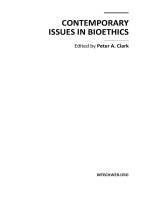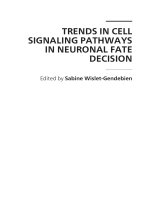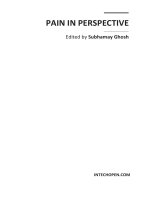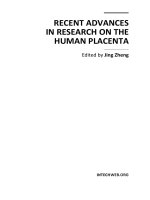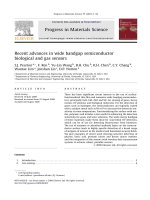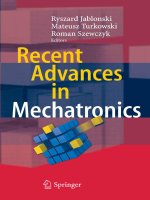Recent Advances in Scoliosis Edited by Theodoros B. Grivas pot
Bạn đang xem bản rút gọn của tài liệu. Xem và tải ngay bản đầy đủ của tài liệu tại đây (22.86 MB, 356 trang )
RECENT ADVANCES
IN SCOLIOSIS
Edited by Theodoros B. Grivas
Recent Advances in Scoliosis
Edited by Theodoros B. Grivas
Published by InTech
Janeza Trdine 9, 51000 Rijeka, Croatia
Copyright © 2012 InTech
All chapters are Open Access distributed under the Creative Commons Attribution 3.0
license, which allows users to download, copy and build upon published articles even for
commercial purposes, as long as the author and publisher are properly credited, which
ensures maximum dissemination and a wider impact of our publications. After this work
has been published by InTech, authors have the right to republish it, in whole or part, in
any publication of which they are the author, and to make other personal use of the
work. Any republication, referencing or personal use of the work must explicitly identify
the original source.
As for readers, this license allows users to download, copy and build upon published
chapters even for commercial purposes, as long as the author and publisher are properly
credited, which ensures maximum dissemination and a wider impact of our publications.
Notice
Statements and opinions expressed in the chapters are these of the individual contributors
and not necessarily those of the editors or publisher. No responsibility is accepted for the
accuracy of information contained in the published chapters. The publisher assumes no
responsibility for any damage or injury to persons or property arising out of the use of any
materials, instructions, methods or ideas contained in the book.
Publishing Process Manager Ana Skalamera
Technical Editor Teodora Smiljanic
Cover Designer InTech Design Team
First published May, 2012
Printed in Croatia
A free online edition of this book is available at www.intechopen.com
Additional hard copies can be obtained from
Recent Advances in Scoliosis, Edited by Theodoros B. Grivas
p. cm.
ISBN 978-953-51-0595-4
Contents
Preface IX
Section 1 Aetiology – Pathogenesis of Idiopathic Scoliosis 1
Chapter 1 Hypothesis on the Pathogenesis of Idiopathic Scoliosis 3
F.H. Wapstra and A.G. Veldhuizen
Chapter 2 How to Improve Progress in Scoliosis Research 23
Keith M. Bagnall
Chapter 3 Ritscher – Schinzel Syndrome
– 3C (Cranio-Cerebello-Cardiac) Syndrome: Case Report 39
Sibila Nankovic, Sanja Hajnsek, Zeljka Petelin,
Andreja Bujan Kovac and Vlatko Sulentic
Chapter 4 Sensorimotor Integration
in Adolescent Idiopathic Scoliosis Patients 47
Jean-Philippe Pialasse, Martin Descarreaux,
Pierre Mercier, Jean Blouin and Martin Simoneau
Section 2 Assessment of Idiopathic Scoliosis 71
Chapter 5 Virtual Anatomy of Spinal
Disorders by 3-D MRI/CT Fusion Imaging 73
Junji Kamogawa and Osamu Kato
Chapter 6 Quantitative MRI for Scoliosis Follow-Up 85
Périé Delphine
Chapter 7 Moiré Topography: From Takasaki Till Present Day 103
Flávia Porto, Jonas L. Gurgel,
Thaís Russomano and Paulo T.V. Farinatti
Chapter 8 Three-Dimensional Assessment of the Scoliosis 119
Jean Legaye
VI Contents
Chapter 9 Emerging Technology and Analytical
Techniques for the Clinical Assessment of Scoliosis 145
Karl F. Zabjek and Reinhard Zeller
Chapter 10 Predicting Curve Progression in Adolescent Idiopathic
Scoliosis - An Outline of Different Indicators of Growth 165
Iris Busscher and Albert G. Veldhuizen
Chapter 11 The Impact of Spinal Deformity
on Gait in Subjects with Idiopathic Scoliosis 173
Agnieszka Stępień
Chapter 12 Characteristics of Body Posture
in Children and Youth with Hearing Disorders 193
Elżbieta Olszewska and Dorota Trzcińska
Section 3 Treatment of Idiopathic Scoliosis 209
Chapter 13 Scoliosis Idiopathic? The Etiologic Factors
in Scoliosis Will Affect Preventive
and Conservative Therapeutic Strategies 211
Piet J.M. van Loon
Chapter 14 Long-Term Outcome of Surgical
Treatment in Adolescent Idiopathic Scoliosis 235
Franz Josef Mueller, Herbert Gluch
and Cornelius Wimmer
Chapter 15 Complications in Scoliosis Surgery 263
Femenias Rosselló Juan Miguel
and Llabrés Comamala Marcelino
Section 4 Health Related Quality of Life in Idiopathic Scoliosis 279
Chapter 16 Health Related Quality
of Life in Adolescents with Idiopathic Scoliosis 281
Elisabetta D’Agata and Carles Pérez-Testor
Chapter 17 Psychological Aspects
of Scoliosis Treatment in Children 301
Ryszard Tomaszewski and Magdalena Janowska
Section 5 The Patient’s Perspective 309
Chapter 18 Untreated Early Onset Scoliosis
- The Natural Progression
of a Debilitating and Ultimately Deadly Disease 311
Janez Mohar
Contents VII
Section 6 Congenital Scoliosis 329
Chapter 19 Congenital Kyphoscoliosis Due
to Hemivertebra Treatment Options and Results 331
Andrés Chahin Ferreyra and Gonzalo Arriagada Ocampo
Preface
Idiopathic scoliosis (IS) is of yet unknown aetiology and its treatment is symptomatic
and not aetiological. Every effort must be undertaken to reverse this treatment into
aetiological. Professor RG Burwell, a recognised authority in the study of IS aetiology,
states that “although considerable progress had been made in the past two decades in
understanding the etiopathogenesis of adolescent idiopathic scoliosis (AIS), it still
lacks an agreed theory of etiopathogenesis. One problem may be that AIS results not
from one cause, but several that interact with various genetic predisposing factors”.
Epigenetic concepts, which may relate to AIS pathogenesis, were also recently
introduced and reported.
The first two chapters of this book focus on concepts related to the pathogenesis of IS
and provide suggestions for improving scoliosis research. A related chapter tapping
the aetiological aspects of IS reports on the Ritscher-Schinzel syndrome. The chapter
on Sensorimotor Integration in AIS Patients provides some evidence of a relation
between IS and dysfunction of neurological mechanisms. In the chapter “Virtual
Anatomy of Spinal Disorders by 3-D MRI/CT Fusion Imaging” the methods used in
the authors’ hospital for obtaining, evaluating and displaying 3-D MRI/CT fusion
imaging are discussed, focusing on their application in the field of spinal surgery.
The chapter entitled “Quantitative MRI for Scoliosis Follow-Up” introduces the MRI
parameters and presents how they are acquired in vivo. The studies on MRI
parameters of bone are presented, in order to show how these parameters may be
involved in bone health research related to scoliosis. The same chapter describes the
studies on the relation between MRI parameters and biochemical or mechanical
properties of the intervertebral disc. It focuses on the relationships between MRI
parameters and muscle properties, as well as the possible applications to scoliosis.
Finally, the potential of quantitative MRI to become a very important diagnostic and
treatment assessment tool in scoliosis is discussed.
The chapter “Moiré Topography: From Takasaki Till Present Day” presents a literature
review on the main characteristics of the Moirι phenomenon, and its use as a
topographical method for the clinical diagnosis of postural deviations. The chapter
entitled “Three-Dimensional Assessment of the Scoliosis” reports on spine assessment
in 3D through reconstruction models, and discusses their importance for the diagnosis,
X Preface
the follow-up and the treatment of scoliosis. The chapter entitled “Emerging
Technology and Analytical Techniques for the Clinical Assessment of Scoliosis”
provides an overview of current clinical models for the assessment of scoliosis, and
brings to attention new approaches that may allow enhancing fundamental
knowledge and complementing clinical models of assessment. In the same chapter, the
theoretical construct of posture is also reviewed and the clinical terms and frames of
reference are identified which are commonly adopted to describe the posture of
children and youth with IS. The chapter also identifies and discusses the potential of
emerging techniques that may enhance current clinical models of assessment. The
chapter “Predicting Curve Progression in Adolescent Idiopathic Scoliosis - An Outline
of Different Indicators of Growth” provides a concise outline of several indicators of
growth and curve progression, thus offering a clear overview of which indicators can
be helpful in predicting the timing of pubertal growth spurt and therefore the timing
of possible scoliosis progression. In “The Impact of Spinal Deformity on Gait in
Subjects with Idiopathic Scoliosis” the authors describe various walking disorders in
subjects with different types of scoliosis, which were measured by appropriate
systems and instruments. The chapter “Characteristics of Body Posture in Children
and Youth with Hearing Disorders” aims to assess the body posture of children and
youth with hearing impairment, with an emphasis on the frequency of the occurrence
of abnormalities. The percentage of abnormalities in the body posture is defined,
which allows for corrective work to be planned.
In the chapter “Scoliosis Idiopathic? The Etiologic Factors in Scoliosis Will Affect
Preventive and Conservative Therapeutic Strategies” the author presents a novel
conservative therapeutic model. In “Long-Term Outcome of Surgical Treatment in
Adolescent Idiopathic Scoliosis” the authors present their long-term results of
posterior instrumentation and spondylodesis in patients with AIS, and critically
review original papers, compiled in a chronological manner, that present long-term
results. In “Complications in Scoliosis Surgery” the authors review the published
literature on complications related to surgical treatment of scoliosis.
“Health Related Quality of Life in Adolescents with Idiopathic Scoliosis” attempts to
deepen the concept of HRQOL and to understand how it is used, as well as its strong
and weak points. The authors intend to complement the medical model with the
psychological one, in a bio-psycho-social framework. The chapter “Psychological
Aspects of Scoliosis Treatment in Children” emphasises the fact that the patients with
scoliosis and their families need to be provided with psychological support through
the whole period of the treatment, and discusses related issues.
The patient’s perspective is described in "Untreated Early Onset Scoliosis - The
Natural Progression of a Debilitating and Ultimately Deadly Disease”. A case of an
adult patient with untreated early onset IS is presented; evidence-based facts and data
regarding health related issues, natural progression and surgical management of
untreated early onset and AIS that results in severe adult deformity is summarized.
In “Congenital Kyphoscoliosis due to Hemivertebra” the treatment options and results
for this congenital disease are reviewed.
Preface XI
Closing this short introduction to this open access book, I would like to express my
gratitude to all authors for their enthusiasm and willingness to document their
knowledge and share it with all peers interested in scoliosis. I would also like to thank
Mrs Ana Skalamera, the Publishing Process Manager, and InTech Open Access
Publisher for inviting me to do the editorship of this book.
Dr Theodoros B. Grivas, MD, PhD
Orthopaedic and Spinal Surgeon
Director of the Trauma and Orthopaedic Department
“Tzanio” General Hospital of Piraeus,
Greece
Section 1
Aetiology – Pathogenesis
of Idiopathic Scoliosis
1
Hypothesis on the Pathogenesis
of Idiopathic Scoliosis
F.H. Wapstra and A.G. Veldhuizen
University Medical Center of Groningen
The Netherlands
1. Introduction
Idiopathic scoliosis is a deformity of the torso, characterized by lateral deviation and axial
rotation of the spine. Although good anatomic descriptions of the structural changes seen in
scoliosis were first made by the ancient Greeks, we have not as yet elucidated its
pathogenesis. The deformity always develops from a straight spine into a curved spine,
usually accompanied by a rib cage deformity, during the growth period in general and in
particular in the rapid growth period. In the growing scoliotic spine, the loss of mechanical
stability results in deformation of the vertebral bodies and ribs. The eventual magnitude of
an idiopathic scoliotic curve varies and is unpredictable. The extent of the alterations in the
shape of the vertebrae and ribs is strongly related to the severity of the scoliotic curve. Pain
is a rare symptom, and the patient seems unaware of his or her condition. The idiopathic
scoliotic curves follow a geometric pattern: (1) primary thoracic; (2) thoraco-lumbar; (3)
primary lumbar (4) double primary. The primary curve invariably has associated secondary
curves which follow similar geometric pattern. The axial rotation of the vertebrae is towards
the convexity of the curve (Boos & Aebi, 2008). The most important problem related to
scoliosis is progression of the deformity, i.e. worsening of the scoliotic curve. The amount of
progression is different in each individual patient, some progress very fast, others don’t
progress at all (Charles et al, 2006; Cheung et al, 2005 & 2006; Dimeglio, 2001; Escalada et al,
2005; Sanders et al, 2007; Wever et al, 2000; Yronen & Ylikoski, 2006). Earlier when the
growth velocity of the spine is 20 mm/year or more, the idiopathic scoliosis is nearly always
progressive (Cheung et al, 2004). When growth is completed progression generally stops,
although research has shown that the risk of curve progression is primarily related to
periods of rapid skeletal growth of the patient, most often during the pubertal growth spurt.
It was shown that curves of more than 40 degrees Cobb angle are able to progress even after
skeletal maturity, because of degeneration of the disk and the fibro-cartilage at load transfer
points on the concave side of the curve, although this progression will be at a very low rate
of 1° or 2° a year (Duval-Beaupere et al, 1970; Duval-Beaupere & Lamireau, 1985). The
prevalence of scoliosis is approximately 4% of the children between 10 and 16 years of age.
However, adolescent idiopathic scoliosis does not necessarily progress, and the prevalence
of children having a Cobb angle larger than 45 degrees, and therefore needing operative
treatment, is approximately 0.1%. Spontaneous improvement is however rare and almost
never seen in moderate to large curves. Although many types or causes of scoliosis are
known, the idiopathic variety comprises the largest group (80%) and its aetiology remains
Recent Advances in Scoliosis
4
unknown. A strong familiar history is usual and a hereditary transmission suggesting an
autosomal dominant or multifactorial defect is described (Duthie, 1959; Duval-Beaupere et
al, 1970). The effect of industrial environmental factors been investigated, but those factors
probably do not significantly influence the prevalence of AIS (Grivas et al, 2008). Some
workers favour a neuromuscular basis for the condition, others believe that asymmetrical
growth is the primary etiological factor (Deacon et al, 1984 & 1987; Dickson et al, 1984;
Duthie, 1959; Millner & Dickson, 1996).
Some workers have attributed the initial spinal
deformity of AIS to changes in ribs ( Pal, 1991; Burwell et al, 1992; Grivas et al, 1991, 1992,
2002, 2007 & 2008; Sevastik, 2000; Sevastik et al, 2003; Erkula et al, 2003). Many workers hold
the view that the rib deformities of progressive AIS are adaptations to forces imposed by the
scoliotic spine (Wever et al, 1999; Burwell et al, 2003) with the sternum, held nearly
stationary by abdominal ties and providing the opposing forces needed to deform the ribs
(Closkey & Schultz, 1993).Whatever factors underlie the aetiology, they ultimately express
themselves in the biomechanical changes that define scoliotic curve progression. This paper
proposes a possible model for the pathomechanics of idiopathic scoliosis.
2. Neuromuscular factors
Awareness of the position of the body in space is a highly developed sense in humans. It is
the result of input from the vestibular, visual and proprioceptive neural pathways. In recent
years, strong evidence has been found for the idea that, for visuomotor co-ordination and
exploration of space, the brain uses abstract, neural representations of space interposed
between sensory input and motor output. These neural representations seem to be
organised in nonretinal, body-centred and/or world-centred coordinates (Andersen et al,
1993; Snijder et al, 1993).
Spatial information in non-retinal coordinates allows the subject to
determine the body position with respect to visual space, which is a necessary prerequisite
for accurate behaviour in space. To obtain such a frame of reference, the information coded
in coordinates related to the peripheral sensory organs must be transformed and integrated.
Defective postural equilibrium has been proposed as a contributing factor in the
development of scoliosis (Guyton, 1976). In this regard, defects in visual and vestibular
input have been studied extensively as a possible genesis of idiopathic scoliosis (Herman &
McEwen, 1979; Herman et al, 1982 & 1985; Sahlstrand et al, 1979; Sahlstrand & Petruson,
1979; Sahlstrand & Lindstrom, 1980; Sahlstrand, 1980; Kapetanos et al, 2002). The occurrence
of vestibular-related deficits in AIS patients is well established but it is unclear whether a
vestibular pathology is the common cause for the scoliotic syndrome and the gaze/posture
deficits or if the latter behavioral deficits are a consequence of the scoliotic deformations. A
possible vestibular origin was tested in the frog Xenopus laevis by unilateral removal of the
labyrinthine end organs at larval stages. After metamorphosis into young adult frogs, X-ray
images and three-dimensional reconstructed micro-computer tomographic scans of the
skeleton showed deformations similar to those of scoliotic patients. The skeletal distortions
consisted of a curvature of the spine in the frontal and sagittal plane, a transverse rotation
along the body axis and substantial deformations of all vertebrae (Lambert et al, 2009). A
clinical study from Wiener-Vacher (Wiener-Vacher & Mazda, 1998) supports the hypothesis
that central otolith vestibular system disorders lead to a vestibule-spinal system imbalance,
and may be a factor in the cause of AIS. In a pilot study on scoliotic patients we used
Vestibular Evoked Myogenic Potentials (VEMP) (Hain et al, 2006). The purpose of the
VEMP test is to determine if the saccule, one portion of the otoliths, as well the inferior
Hypothesis on the Pathogenesis of Idiopathic Scoliosis
5
vestibular nerve and central connections, are intact and working normally. The saccule,
which is the lower of the two otolithic organs, has a slight sound sensitivity and this can be
measured. This sensitivity is thought to be a remnant from the saccule's use as an organ of
hearing in lower animals. We found an asymmetry in Idiopathic scoliosis patients and not in
other types of scoliosis (unpublished data). Vestibulo-ocular reflex changes may be viewed
as a function of asymmetrical control of reflex gain, which is disturbed further during any
postural task requiring control of body motion in the presence of visual fixation. Hence,
postural instability is ascribed to the conflict between visual and vestibular information
within the higher central nervous system (CNS) centres, which can integrate and calibrate
converging sensory data for perception and control of postural movement (Herman &
McEwen, 1979; Herman et al, 1979 & 1985). Proprioceptive input from joints, ligaments and
tendons has been recognised as an integral contribution to the body’s postural equilibrium
Guyton, 1976). Defects in the muscle spindle system and tone in the spinal muscles have
been implicated in scoliosis (Barrack et al, 1984; Hoogmartens & Basmajian, 1976; Low et al,
1978; Matthews, 1969; Matthews, 1969, Whitecloud et al, 1984; Yekutiel et al, 1981). Neural
pathways involving visual, vestibular and proprioceptive afferents all have discrete
interconnections in the brainstem. A lesion in this anatomical location could affect all three
pathways. Congenital lesions in this area are associated with scoliosis (Tezuka, 1971), and
scoliosis has been successfully induced by damaging this area (Dubousset et al, 1982).
Experimentally created defects in the vestibular system of a rat resulted in delayed posture
and motor development (Geisler, 1997). Previous studies of CNS function in AIS have
suggested that altered cerebral cortical/subcortical function (Herman & McEwen, 1979;
Mixon & Steel, 1982; Petersen et al, 1979; Sahlstrand et al, 1979) or hemispherical dominance
(Enslein & Chan, 1987) may be related to the aetiology of AIS. Patients with scoliosis and
primary alteration of the motor system, so-called neuromuscular scoliosis, are known to
have a curve morphology and natural history very different from that of the “typical”
idiopathic curve. Magnetic resonance imaging studies of the brain stem in adolescent
idiopathic scoliosis by Geissele et al. showed an asymmetry in the ventral pons or medulla
in a number of patients (Geissele et al, 1991). Abnormalities in the paraspinal muscles have
been implicated by several investigators as a possible causative factor in the production and
progression of adolescent idiopathic scoliosis (Fidler et al, 1974; Fidler & Jowett, 1976; Ford
et al, 1984; Spenser & Eccles, 1976; Yarom & Robin, 1979). An increased myoelectric response
on the convex side of the curve, near its apex, was the main finding reported by various
authors ( Alexander & Season, 1978; Alexander et al, 1978; Butterworth & James, 1969; Guth
& Abbink, 1980; Henssge, 1962; Redford et al, 1969; Spenser & Eccles, 1976; Wong et al, 1980;
Yarom & Robin, 1979; Zetterberg et al, 1984), but not all agreed on the meaning of these
findings. In early reports a fatigue mechanism was suggested (Riddle & Roaf, 1955), while
others explained the difference as an effect of the stretching of the erector spinae muscles on
the convex side (Butterworth & James, 1969).
This view was supported by the finding of a stretch reflex (H-reflex) that was more sensitive
to vibration and hammer tapping on the spinous processes in larger curves (Hoogmartens &
Basmajian, 1976). Others believed that the increased myoelectric activities on the convex side
were only a secondary effect of the muscles adapting to a higher load demand in larger
curves (Zetterberg et al, 1984). This would be consistent with the reported findings of
differences in the morphology of the paravertebral muscles between the left and right sides (
Saltin et al, 1977; Spenser & Eccles, 1976; Wong et al, 1980; Yarom & Robin, 1979). However,
Recent Advances in Scoliosis
6
the increase of type 1 muscle fibres on the convex side can be explained on the basis of
muscle denervation ( Ford et al, 1984; Webb, 1973 & 1981; Zetterberg et al, 1984), produced
by an alteration of the motor drive arising at the spinal cord level, either from altered
sensory input at the same level ( Pincott, 1980; Pincott & Taffs, 1982; Taffs et al, 1979) or from
a central mechanism ( Barrack et al, 1984; Dubousset et al, 1982; Michelsson, 1965;
Sahlstrand et al, 1979; Whitecloud et al, 1984). The ocular and postural control systems reach
maturation in early adult life (Forssberg & Nasher, 1982; Nasher, 1982; Sharp et al, 1979).
Children with idiopathic scoliosis in the age range of 9–16 years exhibit delay in the
complete development of smooth pursuit and optokinetic nystagmus; moreover, they
demonstrate a delay in tasks that couple the vestibular and visual systems, particularly
those requiring voluntary suppression of the vestibulo-ocular reflex (Herman & McEwen,
1979). This behaviour is required to ensure optimal visual acuity in phase with head motion.
Incomplete maturation of visual and visuo-vestibular functioning is ascribed to inefficient
extraretinal processing of perceptual information by cortical structures within the CNS, e.g.
to delayed development of perception of the position of visual images in space (Herman &
McEwen, 1979; Sharp & Rabinovitch, 1979; Yasui & Young, 1976; Young, 1977). The
maturation of the ocular and postural control systems coincides with the secondary rapid
growth period. Some workers believe that not only the somatic nervous system is involved
but the autonomic nervous system as well (Burwell, 2003; Grivas et al, 2009; Burwell et al,
2009). AIS in girls may then be the result from developmental disharmony expressed in
spine and trunk between autonomic and somatic nervous systems. The autonomic
component involves selectively increased sensitivity of the hypothalamus to circulating leptin
(genetically-determined up-regulation possibly involving inhibitory or sensitizing
intracellular molecules, such as SOC3, PTP-1B and SH2B1 respectively), with asymmetry as
an adverse response (hormesis); this asymmetry is routed bilaterally via the sympathetic
nervous system to the growing axial skeleton where it may initiate the scoliosis deformity.
We propose, therefore, that the most likely cause of idiopathic scoliosis includes a
neuromuscular condition and an asymmetry of the transversospinalis muscles, produced by
alteration of the motor drive at the spinal cord level, either from altered sensory input at the
same level or from a central mechanism, which may produce enough lateral deviation and
axial rotation to disturb the delicate balance of forces in the region, thereby producing an
idiopathic scoliosis. Growth disturbance may not be a primary cause of idiopathic scoliosis,
but it certainly plays a prominent part in the progression of this deformity, although it is not
very clear how.
2.1 Spinal growth factor
Researchers of spinal deformity have always been interested in spinal growth and its
relationship to spinal curvature. Normal longitudinal growth does not proceed in a uniform,
linear pattern (Tanner, 1962 & 1978; Tanner & Davies, 1985; Tanner et al, 1965). There are
two periods of rapid growth, the first from birth to three years of age, and the second during
the adolescent growth spurt. The intervening period is a period of quiet but steady growth.
For over 100 years the association between idiopathic scoliosis and vertebral growth has
been debated (Anderson et al, 1965; Burwell & Dangerfield, 1974; Calvo, 1957; Duthie, 1959;
Duval-Beaupere et al, 1970; Duval-Beaupere & Lamireau, 1985). A large number of studies
on growth differences between normal and scoliotic girls have been conducted.
Hypothesis on the Pathogenesis of Idiopathic Scoliosis
7
Unfortunately, the results of these studies were not consistent. Willner observed a taller
mean standing height in girls with scoliosis compared to healthy controls (Willner, 1974 &
1975 & 1975). These findings were supported by other cross-sectional studies (Buric &
Momcilovic, 1982; Hagglund et al, 1992; Leong et al, 1982; Low et al, 1978; Nordwall &
Willner, 1975; Normelli et al, 1985; Shohat et al, 1988). Loncar-Dusek et al. demonstrated a
higher peak velocity for scoliotic children (Loncar-Dusek, 1991). Moreover, Goldberg et al.
and Ylikowski et al. reported that girls with adolescent idiopathic scoliosis (AIS) have an
earlier growth spurt and earlier attainment of adult height compared to healthy nonscoliotic
controls (Goldberg et al, 1993; Ylikowski, 1993). This is in marked contrast to many other
reports, which found no difference in growth pattern or height between AIS patients and
nonscoliotic controls (Drummond & Rogala, 1980; Taylor, 1983; Veldhuizen, 1985;
Veldhuizen et al, 1986). However, one should keep in mind that most of the studies on
growth differences between scoliotic and nonscoliotic girls mentioned above were based
either on length measurements of the sitting height, without correction for the error
introduced by the scoliotic deformity itself, or were corrected using the method described
by Bjure (Bjure et al, 1968) This method overestimates the real length of the spine, and may
not be valid for curves of 30° or less Cobb angle, since they had no patients with such mild
curves in their material (Skogland & Miller, 1981). The advocates of a deviating growth
pattern explain the initiation of idiopathic scoliosis as the result of a greater tendency of
taller and more slender spines to buckle out of the sagittal plane under loading (Dickson et
al, 1984 & 1987; Millner & Dickson, 1996; Smith & Dickson, 1987).
Roaf (Roaf, 1960 & 1966) and Dickson (Dickson et al, 1984 & 1987) explain the pathogenesis
of idiopathic scoliosis as a result of biplane asymmetry. Increased anterior vertebral height
at the apex of the curve with posterior end-plate irregularity characterises the median plane
asymmetry. This lordosis at bony level was an important basis for their theory that thoracic
lordosis, which is caused by a relative overgrowth of the anterior part of the vertebral body,
triggers the initiation of scoliosis by buckling. In a three-dimensionally rendered CT scan
study we have previously described the vertebral and rib deformities in idiopathic scoliosis
(Wever et al, 1999). The observed vertebral deformities suggest that these are caused by
bone remodelling due to an imbalance between forces in the anterior and posterior spinal
column (Meyer, 1866; Wever et al, 1999). In our study, we also noted a minimal wedge
deformation in the local sagittal plane in certain apical vertebrae, as mentioned by Deacon
and Dickson, but it is questionable whether this deformation in the sagittal plane is a
primary aetiological phenomenon, as they suggest, or whether it is rather a secondary
phenomenon, comparable to the other vertebral deformations. They do not offer an
explanation for this growth disturbance. Deane and Duthie (Deane & Duthie, 1973; Duthie,
1959) found in a cadaveric study that the anterior body lengths either singly, or as total
length were almost normal in the scoliotic patients, but the posterior lengths were
considerably reduced due to a strong inhibitory force to growth of the posterior vertebral
structures. Furthermore, no proof of the “Euler theory”, that idiopathic scoliosis is the result
of buckling under load, has ever been given. The mechanical behaviour of such a complex
and highly non-linear structure as the human vertebral column is very difficult to analyse.
Using a new finite element model of the spine, we have previously examined this buckling
theory (van de Plaats, 1997; van de Plaats et al, 2007). Judging from the results of this finite
element study, buckling can not initiate idiopathic scoliosis, because the characteristic
coupling of lateral deviation and axial rotation is absent. Furthermore, no difference in
Recent Advances in Scoliosis
8
spinal flexibility can be established between patients with idiopathic scoliosis and controls
(Mattson et al, 1983; Veldhuizen, 1985; Veldhuizen & Scholten, 1990). Mechanical and
computer models of the spine are frequently used to analyse the mechanisms by which
scoliosis is initiated and aggravated. In a relatively simple stable physical model of the
trunk, progression of the scoliosis due to growth can be shown (Murray & Bulstrode, 1996;
Nijenbanning, 1998), but there is little evidence that growth initiate idiopathic scoliosis.
The question is what growth is.
2.2 Human growth
Growth is inextricable associated with life. It is defined as a quantitative increase in size or
mass, and it is a consequence of hyperplasia and hypertrophy; i.e. the size of the cells
increases, as well as the number of cells. The term ‘growth’ is generally used for an increase
in height or weight. Several body length dimensions can be measured, like total body
height, sitting height, arm span, foot length, head circumference etc. Leg length is calculated
by protraction of sitting height from total height. The increase in length is calculated per
year, this is called the growth velocity. Unfortunately, in literature several terms are used
alternatively, like growth, growth velocity, height velocity, or growth rate. Often timing or
the magnitude of the growth spurt is simply indicated as peak growth velocity (PGV).
Furthermore, many authors just refer to peak growth velocity of total body height as peak
height velocity. It is often confusing whether the magnitude of the growth velocity is meant,
or the age at which the maximum growth velocity takes place. In this article the term
‘growth’ is used for the increase in a certain length dimension in centimetres. The term
‘growth velocity’ is used for the increase of a certain length dimension per year, expressed
in cm/year. The term ‘peak growth velocity (PGV)’ of a certain length dimension is used for
the maximum growth velocity during adolescence. For example, PGV of total body height,
or PGV of foot length. Growth is a volumetric revolution. From birth onwards, total body
height increases 350% and weight increases 20-fold. Growth involves changes in proportion.
At birth, the lower limbs make up 30% of the total body height in contrast to 48% at skeletal
maturity. The infant head makes up 25% of the total body height and only 13% at skeletal
maturity. All the changes in body length dimensions are gradual and each dimension has its
own period of rapid growth (Busscher et al, 2010 & 2011; Dimeglio, 2001). Tanner (Tanner,
1962 & 1978) was the first to describe the distal-to-proximal growth gradient theory. This
theory states that humans grow “from the outside to the inside”, in other words, distal body
parts will have their growth spurt earlier in adolescence in comparison to more proximal
body parts. Four main characteristics dominate puberty: an increase in total body height,
change of upper and lower body segment proportions, change in overall morphology, and
the development of secondary sexual characteristics. Wide individual variations exist in
onset and duration of puberty, and many factors play a role in the timing of the pubertal
growth spurt. Beyond the age of 10 years, the growth patterns of boys and girls diverge.
This is mainly due to the fact that boys have their pubertal growth spurt later in
adolescence. The average age for the pubertal growth spurt, or the peak growth velocity of
total body height, to occur is between ages 10 and 14 in 95% of the girls and between ages 12
and 16 in 95% of the boys (Gerver & de Bruin, 2001 & 2003; Tanner & Davies, 1985), see
Figure 1A.
Hypothesis on the Pathogenesis of Idiopathic Scoliosis
9
Fig. 1A. Average growth curves and growth velocity curves of boys and girls.
Furthermore, it is known that the magnitude of the peak growth velocity is significantly
larger for those individuals with an early pubertal growth spurt as compared to those with a
late growth spurt (Figure 1B). However, the growth period before the peak is longer and
therefore the ultimate total body height will be similar or higher compared to children with
an early growth spurt (Gerver & de Bruin, 2003; Tanner & Davies, 1985)
Fig. 1B. Examples of growth velocity curves of children having their peak growth velocity at
a different age.
Recent Advances in Scoliosis
10
Generally, the increase in height of the vertebral bodies is the result of enchondral growth at
the upper and lower growth plate (Bick, 1961; Gooding & Neuhauser, 1965; Knuttson, 1961),
whereas the increase in width is a result of periosteal growth (Bick, 1961). It has been
suggested (Neugebauer, 1976) that the regulating(hormonal) mechanism is different for the
two types of bone growth, but there is in fact little definite evidence for the endocrine
pathways by which any particular hormone influences skeletal growth (Sisson, 1971). The
growth of the posterior elements (lamina, pedicles) comes in part from enchondral
ossification initiated in the articular cartilages of the articular processes (Enneking &
Harrington, 1969). Growth can also be described as a mechanical process.
2.3 Growth as a mechanical processi
In his classic “On Growth and Form “D’ Arcy Thompson (D’ Arcy Wentworth Thompson,
1961) analyses biological processes in their mathematical and physical aspects. In his
opinion the form and change of any object in its movement and its growth may be described
as due to the action of forces. In the Newtonian language of elementary physics, force is
recognised by its action in producing or changing motion or in preventing change of motion
or in maintaining rest. In accordance with D'Arcy Thompson’s view we describe growth as a
mechanical process; a process that elapses in time and can be described by mechanical input
and output variables. All parts of the skeleton show visco-elastic behaviour, meaning that a
change in form is the sum of the changes in elastic and viscous transformations. The main
difference between elastic and viscous transformation is time response. Elastic
transformation can be understood as the action of a spring: by putting a weight on a spring,
the length of that spring will increase immediately and after removing this weight, it regains
its original length (Figure 2A). Viscous transformation can be understood as the action of a
damper: by putting a weight on a damper, at first nothing will happen, but after a while the
damper will move. After removing this weight, the damper will remain in its new position.
(Figure 2B)
Fig. 2A. Elastic Element.
Hypothesis on the Pathogenesis of Idiopathic Scoliosis
11
Fig. 2B. Viscous Element.
The growth in bone takes place in the growth-plate. As shown in figure 3 the genesis of
growth can be thought of as a hydraulic system: the barrel left in the drawing contains
liquid under pressure, representing the nursery-room of new cells. The liquid flows through
tubes in which switch-back valves are incorporated to form a piston-cylinder combination.
The liquid pressure will move the piston. Every piston-cylinder combination represents a
growing cell and will produce an internal force on the growth-plate. The pistons are
mechanically coupled resulting in a total force on the growth-plate, called the force of
growth. The displacement of the coupling beam models the increase in length. Unequal
distribution of force on the coupling beam results in an inclination of the coupling beam,
simulating asymmetric growth. The switch-back valve supports the permanent character of
the transformation by growth.
Fig. 3. Genesis of growth, represented as a hydraulic system. The switch-back valve (K)
supports the permanent character of the transformation by growth.
If bone grows the soft tissues like muscles and ligaments have to follow and increase their
length as well against their own tractive powers. This force is referred to as Soft tissue
Complex Force and opposes growth. As shown in figure 4 this Soft Tissue Complex Force
will induce a suction tension through traction on the piston. If the suction force is larger
than the spring-force on the switch-back valve, liquid will flow into the cylinder. The
lengthening will be permanent through the action of the switch-back valve. Only one piston-
cylinder combination has been drawn, representing the total of growing cells.
Recent Advances in Scoliosis
12
Fig. 4. Hydraulic representation of traction Force: F
Soft Tissue Complex
.
In figure 5 a scheme of the growth-process of bone-soft tissue combination is presented. The
in the growth-plate generated Force of Growth will induce growth in bone but will be
inhibited by the Force of Soft Tissue Complex, required for lengthening of soft tissue.
Fig. 5. A scheme of growth process of bone and soft tissue is presented.
The difference between these two forces creates a growth-velocity in bone resulting in
growth only if there is a positive force difference. This mechanical concept of growth
explains easily the greater length of bony elements in Marfan Disease: the force of soft tissue
complex will be smaller and will have a less opposing effect on the force of growth.
Fig. 6. Growth-process.
Hypothesis on the Pathogenesis of Idiopathic Scoliosis
13
In table 1 a summary of forces acting on the spine are given. For the growth process only the
Force of Growth and the Force of Soft Tissue Complex are important. The other forces,
mentioned in table 1, act relatively too shortly to influence the slow reacting viscous
elements.
Forces
Duration of Action Effect
Gravity Long
Ligaments/muscles passive Short Viscous
Muscles active Short
External load Short
Growth Long Viscous
Table 1. Summary of forces, acting on the spine.
Our basic model of growth shows a one- dimensional situation: bone-growth equals soft
tissue lengthening. In practice the soft tissue will show a non-linear and dynamic behaviour.
The introduction of a joint makes the system multi-dimensional and enables small rotation
of skeletal parts as a result of growth. Sometimes these small rotations are part of nature’s
plan, e.g. when considering the formation of the s-shape in the sagittal plane during the first
years of life.
3. Curve progression
The initiation of idiopathic scoliosis can be explained on the basis of a neuromuscular
condition. However, the proposed neurological defects are not correlated with the degree of
subsequent progression for the curve. According to Perdriolle (Perdriolle et al, 1993) the
progression of idiopathic scoliosis is the result of a mechanical phenomenon. It has been
demonstrated that the expected spinal growth at the moment that the initial curve is
diagnosed is of crucial importance for the further development of scoliosis (Lonstein &
Carlson, 1984). In a recent study, we demonstrated that progression of an idiopathic scoliotic
curve correlates with periods of moderate and rapid growth, measured on successive
radiographs (Wever et al, 2000).The variations in growth speed across individuals, as seen in
our study, may explain the variations in expression of AIS, together with other factors such
as the type of curve. Different biomechanical mechanisms are given to explain scoliosis
progression during spinal growth (Kamman, 2003; Pincott & Taffs, 1982; van de Plaats, 1997;
van de Plaats et al, 2007; Raso, 1998). It has been suggested that asymmetrical growth of the
apical vertebral bodies due to chronic axial asymmetrical loading on the physes, according
to the Hueter- Volkmann law, may result in scoliosis progression (Agadir et al, 1988;
Perdriolle et al, 1993). Stokes et al. quantified the relationship between the degree of a
symmetrical loading and the degree of asymmetrical growth in a rat-tail model and
confirmed that vertebral wedging results from asymmetric growth in the physes (Stokes et
al, 1996). In our study, there was a strong correlation between the degrees of apical vertebral
deformation (wedging) and the degree of lateral deviation (Cobb angle), meaning that more
vertebral deformation was found in more severe curves (Wever et al, 1999 & 2000).
However, we have not found a direct relation between curve progression and an increase in
wedging in progressive scoliosis. Others have stressed the importance of the posterior
musculo-ligamentous structures of the spinal column, which have a strong tendency to



